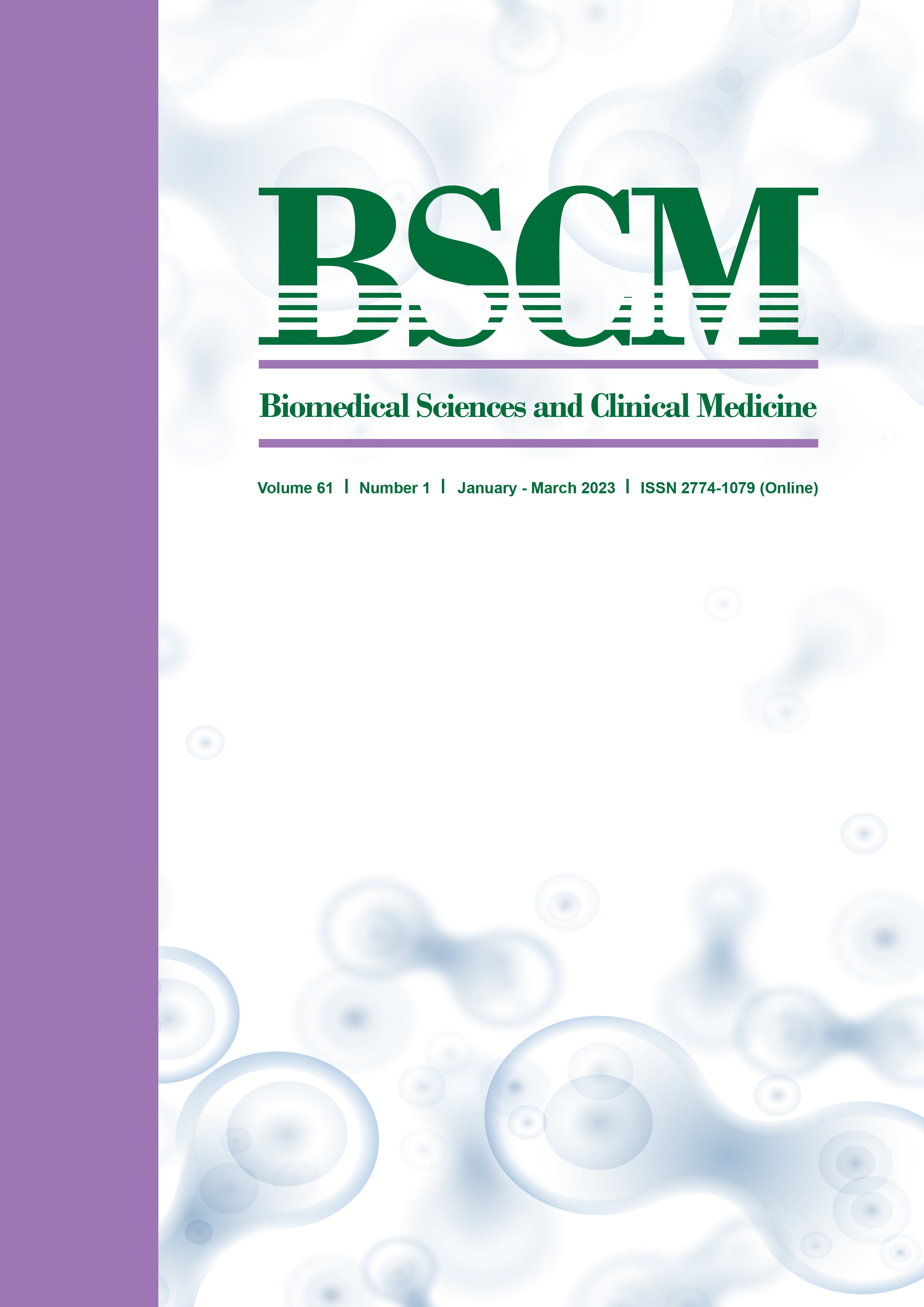Treatment Outcomes of Transcatheter Closure in Common Congenital Heart Disease: Success Rate and Short-term Complications
Main Article Content
บทคัดย่อ
OBJECTIVE This study aimed to investigate treatment outcomes, including success rates and any short-term complications of transcatheter closure in common congenital heart disease (CHD), ventricular septal defect (VSD), atrial septal defect (ASD) and patent ductus arteriosus (PDA) at our tertiary cardiac center.
METHODS This retrospective study was conducted at Naresuan University Hospital, Thailand. We enrolled patients for the analysis who had undergone transcatheter device closure (VSD, ASD and PDA) from October 2011 through May 2018. Treatment outcome success is defined as complete closure at 1 day, 1 month and 6 months following the procedure. Major complications associated
with transcatheter device closure such as device embolization, arrhythmia, cardiac tamponade, thromboembolism, cardiac erosion and death were also collected.
RESULTS Ninety-four patients, ranging from children to adults, were enrolled. ASD, PDA and VSD device closure was done in 45, 40 and 9 patients, respectively. Overall success at 1 day, 1 month and 6 months following the procedure were 87.3, 92.1 and 96.8%, respectively. There were 2 complications reported, one thromboembolism and one first-degree atrioventricular block (AVB).
CONCLUSIONS Transcatheter closure in common congenital heart diseases provides good treatment outcomes and is safe for all age groups, from children to adults, with only a small number of major complications.
Article Details

อนุญาตภายใต้เงื่อนไข Creative Commons Attribution 4.0 International License.
เอกสารอ้างอิง
Liu Y, Chen S, Zühlke L, Black GC, Choy MK, Li N, et al. Global birth prevalence of congenital heart defects 1970-2017: updated systematic review and meta-analysis of 260 studies. Int J Epidemiol. 2019;48:455-63.
Baumgartner H, De Backer J, Babu-Narayan SV, Budts W, Chessa M, Diller GP, et al. 2020 ESC Guidelines for the management of adult congen-ital heart disease. Eur Heart J. 2021;42:563-645.
Porstmann W, Wierny L, Warnke H. Closure of persistent ductus arteriosus without thoracotomy. Ger Med Mon. 1967;12:259-61.
King TD, Thompson SL, Steiner C, Mills NL. Se-cundum atrial septal defect. Nonoperative closure during cardiac catheterization. JAMA. 1976;235: 2506-9.
Lock JE, Block PC, McKay RG, Baim DS, Keane JF. Transcatheter closure of ventricular septal defects. Circulation. 1988;78:361-8.
O’Byrne ML, Levi DS. State-of-the-art atrial septal defect closure devices for Congenital heart. Interv Cardiol Clin. 2019;8:11-21.
Liu S, Chen F, Ding X, Zhao Z, Ke W, Yan Y, et al. Comparison of results and economic analysis of surgical and transcatheter closure of perimem-branous ventricular septal defect. Eur J Cardio-thorac Surg. 2012;42:e157-62.
Faccini A, Butera G. Atrial septal defect (ASD) device trans-catheter closure: limitations. J Thorac Dis. 2018;10:S2923-30.
Baruteau AE, Hascoët S, Baruteau J, Boudjemline Y, Lambert V, Angel CY, et al. Transcatheter clo-sure of patent ductus arteriosus: past, present and future. Arch Cardiovasc Dis. 2014;107:122-32.
P S, Jose J, George OK. Contemporary outcomes of percutaneous closure of patent ductus arte-riosus in adolescents and adults. Indian Heart J. 2018;70:308-15.
Morray BH. Ventricular septal defect closure de-vices, techniques, and outcomes. Interv Cardiol Clin. 2019;8:1-10.
Saurav A, Kaushik M, Mahesh Alla V, White MD, Satpathy R, Lanspa T, et al. Comparison of per-cutaneous device closure versus surgical closure of perimembranous ventricular septal defects: A systematic review and meta-analysis. Catheter Cardiovasc Interv. 2015;86:1048-56.
Sato J, Kato A, Takeda S, Nishikawa H. Case report: atrioventricular block after transcatheter atrial sep-tal closure using the Figulla® Flex II ASD occluder. Catheter Cardiovasc Interv. 2019;93:E298-301.
Chantepie A, Lefort B, Soulé N, Bonnefoy R, La-barthe F. Atrioventricular block after transcathe-ter atrial septal defect closure using the Amplatzer septal occluder(®). Arch Pediatr. 2013;20:1333-6.
Al-Anani SJ, Weber H, Hijazi ZM. Atrioventricular block after transcatheter ASD closure using the Amplatzer septal occluder: risk factors and rec-ommendations. Catheter Cardiovasc Interv. 2010; 75:767-72.
Khoshhal SQ, Al-Mutairi MB, Alnajjar AA, Morsy MM, Salem SS, Al-Muhaya M, et al. Transcathe-ter device closure of ventricular septal defects in children: a retrospective study at a single cardiac center. Ann Saudi Med. 2020;40:396-402.
Wong SC, Minutello R, Hong MK. Neurological complications following percutaneous coronary interventions (a report from the 2000-2001 New York State Angioplasty Registry). Am J Cardiol. 2005;96:1248-50.
Amin Z, Hijazi ZM, Bass JL, Cheatham JP, Hel-lenbrand WE, Kleinman CS. Erosion of Amplatzer septal occluder device after closure of secundum atrial septal defects: review of registry of compli-cations and recommendations to minimize future risk. Catheter Cardiovasc Interv. 2004;63:496-502.
Mallula K, Amin Z. Recent changes in instructions for use for the Amplatzer atrial septal defect oc-cluder: How to incorporate these changes while using transesophageal echocardiography or int-racardiac echocardiography. Pediatr Cardiol. 2012; 33:995-1000.


